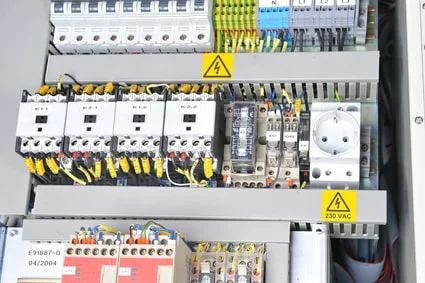The Occupational Safety and Health Administration (OSHA) has specific regulations regarding the labeling of electrical panels in the workplace. Proper labeling of electrical panels is crucial for worker safety, as it quickly identifies potential electrical hazards and aids in troubleshooting electrical issues. OSHA’s electrical labeling requirements are outlined in 29 CFR 1910 Subpart S – Electrical, specifically in section 1910.303(e).
In summary, OSHA requires that electrical equipment such as switchboards, panelboards, industrial control panels, meter socket enclosures, and motor control centers be labeled with enough information to identify the equipment along with any warnings or precautions that need to be heeded. This allows workers to quickly identify equipment and any potential hazards before working on or near the equipment.
Page Contents
OSHA Regulations on Labeling Electrical Panels
Here are the key details on OSHA’s regulations for labeling electrical panels:
- Labels must be permanently affixed or etched onto the equipment and made of durable material.
- Labels must be clearly visible and located so pertinent information is easily identifiable.
- Labels must convey enough information to identify the equipment along with any hazards or precautions.
- Labels must be distinct and descriptive such as “480V MCC” or “208V Branch Circuit Panel.
- Labels that identify hazards must be marked “DANGER.”
- Existing labels on equipment that convey the required information are acceptable.
In section 1910.303(e), OSHA provides additional detail on what information needs to be included on equipment labels:
- Nominal voltage – The voltage the equipment operates at.
- Arc flash boundary – The distance at which an arc flash hazard exists.
- At least one of the following:
- Available incident energy and the corresponding working distance.
- Minimum arc rating of clothing.
- Site-specific level of PPE.
- Current rating of equipment (if service equipment).
Including this important information allows workers to identify potential arc flash hazards and determine the proper personal protective equipment (PPE) that must be worn when working on or near the equipment.
Purpose of Electrical Panel Labels
Properly labeling electrical panels serves several important purposes:
- Safety: Alerts workers to potential electrical hazards and helps prevent arc flash and shock injuries.
- Identification: Allows easy identification of equipment and what it controls or feeds.
- Maintenance: Aids troubleshooting by technicians who need to work on the equipment.
- Compliance: Meets OSHA regulations for labeling electrical equipment.
Having clearly labeled panels and equipment makes a workplace safer by reducing the chances of workers inadvertently being exposed to hazards because they were unaware of the potential danger. Labels serve as permanent visual reminders to exercise caution.
Proper identification labels also increase efficiency by making it easy for workers to quickly determine what equipment they need to access or shut off. Technicians can rapidly identify components to isolate issues.
Types of Electrical Panel Labels
There are a variety of label types that can be used to identify electrical panels and comply with OSHA’s requirements:
Engraved Plastic Labels
Engraved plastic labels are a permanent and durable option for panel labeling. They can be custom engraved with the specific information needed. The engraved lettering does not rub off or fade over time. These labels come in various sizes, materials like laminated vinyl or polyester, and can include graphics or colors.
Self-Adhesive Vinyl Labels
Vinyl self-adhesive labels provide another permanent labeling option. They stick to surfaces securely using a pressure-sensitive adhesive. Vinyl labels resist moisture, abrasion, temperature extremes, and chemical exposure. Custom vinyl labels can be printed with text, colors, and graphics.
Self-Laminating Labels
Self-laminating labels provide durability using a clear laminating film over the printed label. After printing, the label is wrapped in the laminating film providing protection from dirt, grease, moisture, and fading. These labels resist chemicals, abrasion, and temperatures.
Tape Labels
For a low-cost labeling option, vinyl tape printed with the needed information can be used to label panels. The tape adheres securely and is a quick and simple method to label panels. However, it may need to be replaced periodically as tape can fall off or deteriorate over time.
Painted Stenciled Labels
Painting labels onto an electrical panel using stencils provides a cost-effective way to label panels. Stencils customized with the information get placed on the panel and spray painted. However, painting labels directly is less durable than other methods. The paint can chip or fade over time.
Electrical Panel Labeling Best Practices
To meet OSHA standards and properly implement an electrical safety labeling program, businesses should follow these best practices:
- Perform an assessment to identify all electrical equipment that requires labeling, creating a master list for reference.
- Determine the specific information needed on each label, such as voltage, available incident energy, hazards, etc.
- Use ANSI Z535 and other standards to determine proper formats, colors, and lettering for safety hazard warnings.
- Create a labeling schedule and standard procedures for installing and inspecting labels.
- Use permanent and durable labeling methods like engraved plastic or self-laminating labels.
- Place labels in consistent locations on each piece of equipment.
- Train workers on the labeling system so they understand the information on labels.
- Audit the electrical labeling program periodically to check all equipment is properly labeled.
Following standardized labeling procedures ensures labels are accurate, consistent, and provide workers with the safety information they need. Proactive label maintenance also helps labels remain fixed and legible.
Conclusion
Ensuring effective labeling of electrical panels and equipment is a vital part of any electrical safety program. OSHA clearly defines regulatory requirements to make electrical hazards obvious and protect workers from injury through 29 CFR 1910 Subpart S. Using durable and permanent labels that identify equipment, voltage, arc flash information, and precautions allows for a safer work environment. Additionally, proper labeling increases efficiency and aids troubleshooting for maintenance staff. Organizations can improve compliance and safety by implementing best practices for a comprehensive electrical equipment labeling program.
